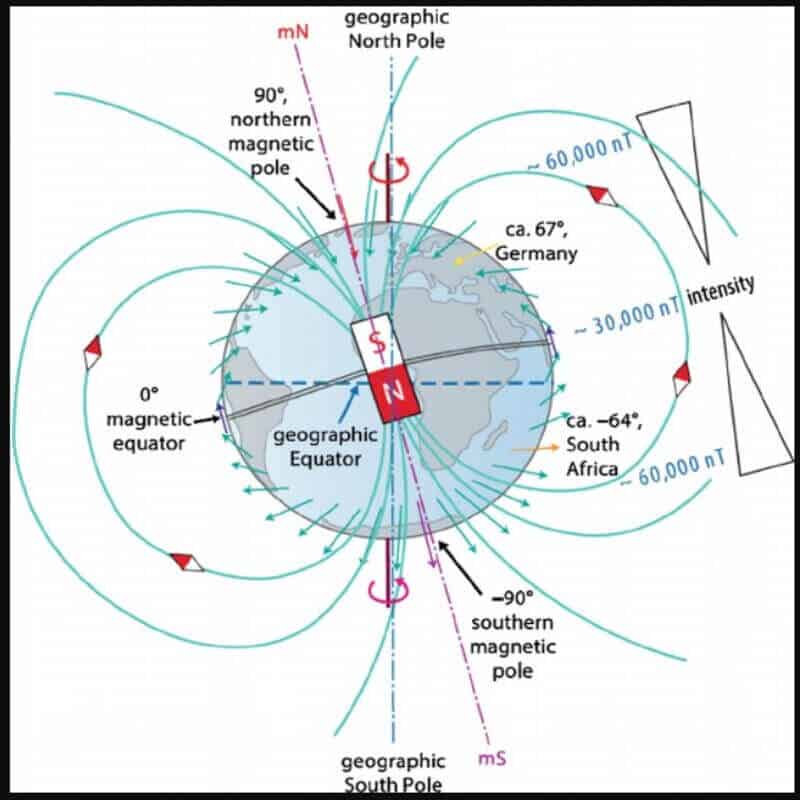
Geomagnetism is the study of the dynamics of the Earth’s magnetic field, which is produced in the outer core. With recent advances in the extent of the study of the earth’s magnetic field, it is important to understand the phenomenon in detail. Read here to know more.
Geomagnetism deals with all aspects of the Earth’s magnetic field, also called the geomagnetic field, that surrounds our habitat in the form of the magnetosphere.
We cannot sense the geomagnetic field in any way, and instrumental measurements such as continuous recordings or dedicated surveys are necessary to study it.
Indian scientists have developed an Overhauser Magnetometer, one of the most accurate magnetometers extensively used by all magnetic observatories around the world.
- This will make way for reducing the cost of sampling and sensing experiments essential for geomagnetic sampling.
- The sensor installed at Alibag Magnetic Observatory (MO) can absolve India’s dependence on commercial OVH magnetometers for performing geomagnetic field measurements.
Also read: JUICE (Jupiter Icy Moons Explorer)
Overhauser Magnetometer
OVH magnetometers are known for their higher accuracy, higher sensitivity, and efficient power consumption and hence find applications in all magnetic observatories worldwide as well as in international space programs.
It has so far been imported for such purposes in India.
To reduce dependence on imports, the Indian Institute of Geomagnetism (IIG), an autonomous research institution under DST, Government of India, has developed the magnetometer as part of its technology development program.
Experiments with the sensor installed at the Alibag Magnetic Observatory (MO) for geomagnetic sampling found that the sensor reproduced the geomagnetic diurnal variations accurately and precisely showed the signatures of various space weather events such as geomagnetic storms, impulses, etc.
The performance of this indigenously made magnetometer is at par with a commercial OVH sensor that is currently installed at the magnetic observatories of IIG.
Future applications of the OVH magnetometer:
- Sensor for outer space environment to support the existing Indian space research program
- Understanding this project, specifically the underlying mechanism of Dynamic Nuclear Polarization (DNP), would also be of potential help to develop a sensitive magnetic resonance imaging (MRI) instrument.
What is geomagnetism?
Geomagnetism is the study of the magnetic field of the Earth.
It originated in ancient China and Greece, where the properties of the natural magnet (lodestone) were recognized for the first time.
The geomagnetic field acts both as an umbrella, shielding us from cosmic radiation, and as a window, offering one of the few glimpses of the inner workings of the Earth.
The magnetosphere (zone in which we can feel the magnetic effect) extends to about 60,000 km over the earth’s surface.
- Earth’s magnetic field extends up to 3200 km which can dispel the solar wind and save earth from disaster.
- It protects us from solar flares and plays an important role in blocking the harmful gamma rays from the sun.
- Without the magnetosphere, the solar wind would erode our atmosphere, devoiding our planet of the life-giving air we breathe.
- The magnetosphere also protects Earth from large quantities of particle radiation emitted during coronal mass ejection (CME) events and also from cosmic rays raining down on Earth from deep space.
- The magnetosphere repels harmful energy away from Earth and traps it in zones called the Van Allen radiation belts.
During particularly strong space weather events such as high solar winds or large CMEs, Earth’s magnetic field is disturbed and geomagnetic storms can penetrate the magnetosphere and lead to widespread radio and power blackouts as well as endangering astronauts and Earth-orbiting satellites.
Geomagnetism provided a very useful tool for recovering past plate motions through the analysis of oceanic magnetic anomalies.
It is known that Earth’s magnetic field has shifted and reversed over time. Because of how slowly it has generally wandered like only 9 km each year, hence scientists can readily keep track of its location.
However, after the turn of the century, this speed climbed to 50 kilometers each year.
Earth’s steady magnetic field is produced by many sources, both above and below the planet’s surface.
Magnetic and Geomagnetic poles

Earth has two sets of poles, geographic poles, and magnetic poles. Earth’s magnetic field can be visualized if you imagine a large bar magnet inside our planet, roughly aligned with Earth’s axis.
- Each end of the magnet lies relatively close (about 10 degrees) to the geographic North and South poles.
- Earth’s invisible magnetic field lines travel in a closed, continuous loop and are nearly vertical at each magnetic pole.
When a magnet is suspended so it may rotate freely, its North pole is imagined to be the pole that is drawn to the Earth’s North Magnetic Pole.
- The North Magnetic Pole of the Earth is the South Magnetic Pole of its Magnetic Field because opposing poles attract.
- The Earth’s rotation axis and the magnetic dipole field are typically aligned fairly closely; in other words, the magnetic poles are typically fairly close to the geographic poles (the earth’s axis passes through these poles), which is why a compass works.
- The north and south magnetic poles flip places, though, when the dipole component of the field reverses after a few thousand years.
- Earth’s magnetic North Pole is quickly moving from the Canadian Arctic towards Russia.
The intersections of the Earth’s surface and the axis of a bar magnet that is hypothetically positioned at the planet’s center are known as the geomagnetic poles (dipole poles).
- The poles are known as “the geomagnetic north pole” and “the geomagnetic south pole,” respectively, and one exists in each hemisphere.
- The geomagnetic dipole is currently inclined at an angle to the Earth’s rotating axis of approximately 11 degrees.
- On the other hand, magnetic needles turn vertically at the magnetic poles (the magnetic north pole and the magnetic south pole).
- The uneven and complicated distribution of the earth’s magnetic field is what causes the discrepancy between the positions of the magnetic and geomagnetic poles.
A geomagnetic reversal or a reversal in earth’s magnetic field is a change in a planet’s magnetic field such that the positions of magnetic north and magnetic south are interchanged.
What causes geomagnetism?
Earth’s magnetic field is generated by what is known as the geodynamo process. For a planet to generate its magnetic field by the geodynamo process, it must have the following characteristics:
- The planet rotates fast enough
- Its interior must have a fluid medium
- The interior fluid must have the ability to conduct electricity
- The core must have an internal source of energy that propels convection currents in the liquid interior.
The generation of Earth’s magnetic field occurs deep within the Earth’s interior, in a layer known as the outer core to be precise.
Geomagnetism on other planets
Earth is not the only planet in the solar system to possess a magnetic field.
Jupiter, Saturn, Uranus, and Neptune all exhibit magnetic fields far stronger than Earth’s.
Though the underlying mechanisms driving these magnetic fields are not yet completely understood.
Mars does not have enough inner heat nor does it possess the liquid interior required to generate a magnetic field.
Venus, on the other hand, has a liquid core but does not spin fast enough to generate a magnetic field.
-Article written by Swathi Satish






Leave a Reply